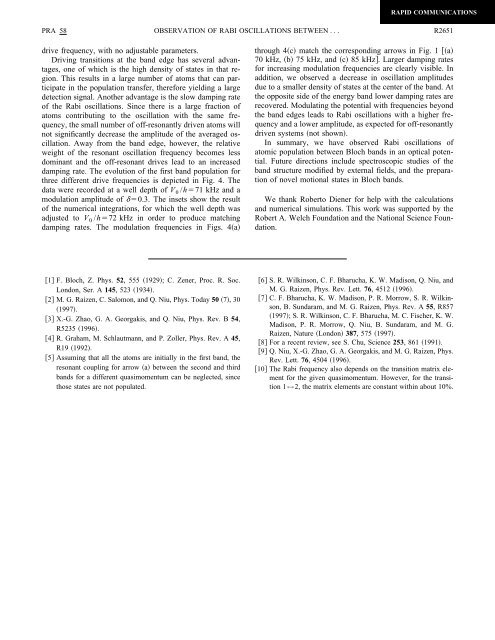Observation of Rabi oscillations between Bloch bands in an optical ...
Observation of Rabi oscillations between Bloch bands in an optical ...
Observation of Rabi oscillations between Bloch bands in an optical ...
Create successful ePaper yourself
Turn your PDF publications into a flip-book with our unique Google optimized e-Paper software.
drive frequency, with no adjustable parameters.<br />
Driv<strong>in</strong>g tr<strong>an</strong>sitions at the b<strong>an</strong>d edge has several adv<strong>an</strong>tages,<br />
one <strong>of</strong> which is the high density <strong>of</strong> states <strong>in</strong> that region.<br />
This results <strong>in</strong> a large number <strong>of</strong> atoms that c<strong>an</strong> participate<br />
<strong>in</strong> the population tr<strong>an</strong>sfer, therefore yield<strong>in</strong>g a large<br />
detection signal. Another adv<strong>an</strong>tage is the slow damp<strong>in</strong>g rate<br />
<strong>of</strong> the <strong>Rabi</strong> <strong>oscillations</strong>. S<strong>in</strong>ce there is a large fraction <strong>of</strong><br />
atoms contribut<strong>in</strong>g to the oscillation with the same frequency,<br />
the small number <strong>of</strong> <strong>of</strong>f-reson<strong>an</strong>tly driven atoms will<br />
not signific<strong>an</strong>tly decrease the amplitude <strong>of</strong> the averaged oscillation.<br />
Away from the b<strong>an</strong>d edge, however, the relative<br />
weight <strong>of</strong> the reson<strong>an</strong>t oscillation frequency becomes less<br />
dom<strong>in</strong><strong>an</strong>t <strong>an</strong>d the <strong>of</strong>f-reson<strong>an</strong>t drives lead to <strong>an</strong> <strong>in</strong>creased<br />
damp<strong>in</strong>g rate. The evolution <strong>of</strong> the first b<strong>an</strong>d population for<br />
three different drive frequencies is depicted <strong>in</strong> Fig. 4. The<br />
data were recorded at a well depth <strong>of</strong> V 0 /h71 kHz <strong>an</strong>d a<br />
modulation amplitude <strong>of</strong> 0.3. The <strong>in</strong>sets show the result<br />
<strong>of</strong> the numerical <strong>in</strong>tegrations, for which the well depth was<br />
adjusted to V 0 /h72 kHz <strong>in</strong> order to produce match<strong>in</strong>g<br />
damp<strong>in</strong>g rates. The modulation frequencies <strong>in</strong> Figs. 4a<br />
1 F. <strong>Bloch</strong>, Z. Phys. 52, 555 1929; C. Zener, Proc. R. Soc.<br />
London, Ser. A 145, 523 1934.<br />
2 M. G. Raizen, C. Salomon, <strong>an</strong>d Q. Niu, Phys. Today 50 7, 30<br />
1997.<br />
3 X.-G. Zhao, G. A. Georgakis, <strong>an</strong>d Q. Niu, Phys. Rev. B 54,<br />
R5235 1996.<br />
4 R. Graham, M. Schlautm<strong>an</strong>n, <strong>an</strong>d P. Zoller, Phys. Rev. A 45,<br />
R19 1992.<br />
5 Assum<strong>in</strong>g that all the atoms are <strong>in</strong>itially <strong>in</strong> the first b<strong>an</strong>d, the<br />
reson<strong>an</strong>t coupl<strong>in</strong>g for arrow a <strong>between</strong> the second <strong>an</strong>d third<br />
<strong>b<strong>an</strong>ds</strong> for a different quasimomentum c<strong>an</strong> be neglected, s<strong>in</strong>ce<br />
those states are not populated.<br />
RAPID COMMUNICATIONS<br />
PRA 58 OBSERVATION OF RABI OSCILLATIONS BETWEEN ...<br />
R2651<br />
through 4c match the correspond<strong>in</strong>g arrows <strong>in</strong> Fig. 1 a<br />
70 kHz, b 75 kHz, <strong>an</strong>d c 85 kHz. Larger damp<strong>in</strong>g rates<br />
for <strong>in</strong>creas<strong>in</strong>g modulation frequencies are clearly visible. In<br />
addition, we observed a decrease <strong>in</strong> oscillation amplitudes<br />
due to a smaller density <strong>of</strong> states at the center <strong>of</strong> the b<strong>an</strong>d. At<br />
the opposite side <strong>of</strong> the energy b<strong>an</strong>d lower damp<strong>in</strong>g rates are<br />
recovered. Modulat<strong>in</strong>g the potential with frequencies beyond<br />
the b<strong>an</strong>d edges leads to <strong>Rabi</strong> <strong>oscillations</strong> with a higher frequency<br />
<strong>an</strong>d a lower amplitude, as expected for <strong>of</strong>f-reson<strong>an</strong>tly<br />
driven systems not shown.<br />
In summary, we have observed <strong>Rabi</strong> <strong>oscillations</strong> <strong>of</strong><br />
atomic population <strong>between</strong> <strong>Bloch</strong> <strong>b<strong>an</strong>ds</strong> <strong>in</strong> <strong>an</strong> <strong>optical</strong> potential.<br />
Future directions <strong>in</strong>clude spectroscopic studies <strong>of</strong> the<br />
b<strong>an</strong>d structure modified by external fields, <strong>an</strong>d the preparation<br />
<strong>of</strong> novel motional states <strong>in</strong> <strong>Bloch</strong> <strong>b<strong>an</strong>ds</strong>.<br />
We th<strong>an</strong>k Roberto Diener for help with the calculations<br />
<strong>an</strong>d numerical simulations. This work was supported by the<br />
Robert A. Welch Foundation <strong>an</strong>d the National Science Foundation.<br />
6 S. R. Wilk<strong>in</strong>son, C. F. Bharucha, K. W. Madison, Q. Niu, <strong>an</strong>d<br />
M. G. Raizen, Phys. Rev. Lett. 76, 4512 1996.<br />
7 C. F. Bharucha, K. W. Madison, P. R. Morrow, S. R. Wilk<strong>in</strong>son,<br />
B. Sundaram, <strong>an</strong>d M. G. Raizen, Phys. Rev. A 55, R857<br />
1997; S. R. Wilk<strong>in</strong>son, C. F. Bharucha, M. C. Fischer, K. W.<br />
Madison, P. R. Morrow, Q. Niu, B. Sundaram, <strong>an</strong>d M. G.<br />
Raizen, Nature London 387, 575 1997.<br />
8 For a recent review, see S. Chu, Science 253, 861 1991.<br />
9 Q. Niu, X.-G. Zhao, G. A. Georgakis, <strong>an</strong>d M. G. Raizen, Phys.<br />
Rev. Lett. 76, 4504 1996.<br />
10 The <strong>Rabi</strong> frequency also depends on the tr<strong>an</strong>sition matrix element<br />
for the given quasimomentum. However, for the tr<strong>an</strong>sition<br />
1↔2, the matrix elements are const<strong>an</strong>t with<strong>in</strong> about 10%.
















